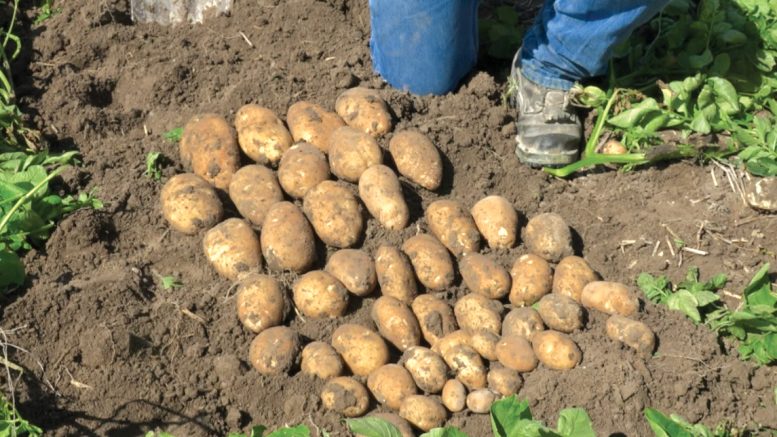By Noel Garcia, Technical Director, TPS Lab
Larry Zibilske, Vice President of Research, TPS Lab
Since the late 1990s, there has been a plateau in potato yields, generally averaging 450 cwt/acre. This can be attributed to many factors including genetics, as well as biotic and abiotic stresses. The heavy removal of nutrients leading to loss of soil fertility contribute to such stress symptoms as potato cyst nematode, potato virus, scab, zebra chip and late blight.
Plants that are nutritionally well balanced in nitrogen, phosphorus and potassium – but especially in the micronutrients (zinc, iron, manganese, copper, boron, silicon and molybdenum) – can resist much more stress during the season. The definition of “well balanced” varies frequently and dramatically throughout the growing season. The nature of the potato crop, when it comes to plant physiology, can be challenging to most growers. But even “good” crop results can still be a long way from achieving its genetic yield, pack-out and quality potential.
Need for Modern Evaluations
Understanding soil health and crop nutrition should be paramount when it comes to increasing yields and quality. Therefore, reliable pre-plant soil tests that include organic matter, pH, electrical conductivity, nitrogen, phosphorus, potassium, sodium, calcium, magnesium, zinc, iron, manganese, copper, boron and molybdenum should be conducted to plan for the season’s nutritional program, then followed by proactively-monitored in-season petiole analyses to forecast seven to 21 days in advance of what the plants will be deficient in before the visual deficiencies occur.
Once you can see problems in the field, they have already cost you production and quality due to crop stress with consequential developmental impairment.
Unfortunately, most laboratories are still using 50+ year-old plant nutrient sufficiency standards to interpret petiole analysis. And recommendations based on soil tests, if given at all, are based on historic yield goals for old varieties – not on modern, updated information, much less recent discoveries in crop nutrition.
In addition, some growers rely only upon soil tests to measure their crops’ nutritional levels while being unaware of their crops’ actual complete nutritional condition. Not only can much happen to fertilizers after they hit the ground to make them unavailable to the plant, but some nutrients are best applied foliarly, especially the micronutrients.
This leads to misinterpretations due to advancements in genetics and differences in nutrient uptake with recent cultivars and varieties. It is important to work with a laboratory that has been updating its plant nutrition standards to higher-yielding varieties as well as an agronomist or crop adviser who can interpret not only the lab results but other dynamic crop physiological, physical, chemical and soil microbial occurrences.
Crop Nutrition Recommendations
Best performance is initially achieved by producing the smallest canopy in the fastest time possible which persists for only as long as it needs to. This is strongly influenced by nitrogen applications. Keeping nitrogen applications (split) to a minimum in the early vegetative stage of growth accomplishes this as long as it is being monitored by regular petiole analyses.
Initial potato petiole analysis should be taken just before tuber initiation (hook stage) and then followed by weekly samplings. Balancing the nutrition early with phosphorus (which increases the number of tubers, growth and dry matter) and potassium (promoting high water use efficiency, disease suppression and dry matter) is extremely important.
Then, the demand increases at tuber bulking-stage when most of the nitrogen, phosphorus and potassium should be applied in split applications. Keeping the micronutrients well balanced, along with calcium and boron for good skin quality and internal spot and hollow/black heart reduction, together with improved stress tolerance, is key to maximizing the genetic potential and achieving yields of 600 or more cwt/acre along with best quality.
It is important to remember that the timing of applications of deficient nutrients at key physiological stages of growth is critical. And studies have shown that nutritionally-balanced crops grown in soil with an active biological component are more robust in resistance to disease and insects, and unfavorable growing conditions.
Investments in soil and plant testing can improve profits and economic sustainability by helping you take full advantage of technological advances in genetics and nutrition to increase productivity while reducing input costs of fertilizer, fungicides and pesticides. These goals can be achieved by combining modern potato varieties with modern testing and understanding of nutritional requirements and crop management practices. Remember the four “R”s of crop nutrition: “Apply the right nutrients in the right amounts in the right place at the right time.”
Editor’s note:
For more information and videos, see TPSLab.com.




